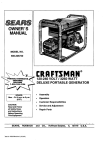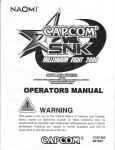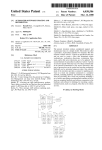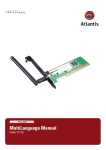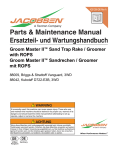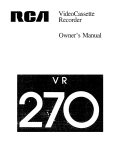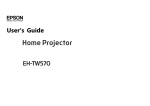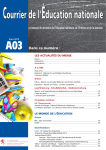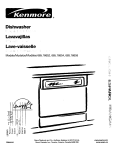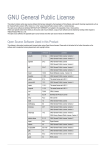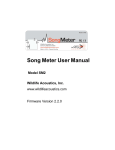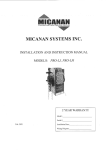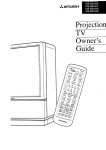Download 0174 - OpenMPE
Transcript
CASE - A Way out of the Software Trap
Geoff Davies
RAET Software Products BV
The Netherlands
1. latrodactioD
One of the hottest topics in the computer industry today is CASE which stands for
Com,uter Ai~ed Software Engineering (or C0lI!puter Ass!sted Syst~ms EngineC?ring). Is this
8Jlotlier meaDlngless acro~m you see for a while, that disappears 18 a short time1 when the
excitement dies down? The acronym could disappear, but (be concept will certamly not go
away, because design and construction of busmess application systems is so vital a
dimension of commerce and industn' today, that our "profession" finds itself under
increasing pressure to behave as Eglineera.
Bn~eers today
are assisted ~ computer technology in the design, visualisation,
manufacture., testing, service, and
quality control of
the products of
their discipline,
such as bnd.&e~ bUildings, automobiles, weapons, satellites, computer chips, and so on.
The terms CAD/l:.AM (~omputerA}ded Design / CotDputer Aided Manufacturing) and CIM (Computer
Integrated Manotactunng) are WIdely known.
So it will go with Application Software development. CASE is the term rapidly gainiDg
aeceptan~e Tor the automation
by computer of the
Software Develppment process.
Automation is being hailed by many as a way out of the Software Trap - the trap we find
ourselves in when we can't make vital new systems quickly or weD enough, because of the
burden of holding together inadequate systems develoPed In the past.
This parr wiD explore the background to CASE the benefits it can deliver, and smest
an idea toolset, es~iaUy with reaard to the Hi-3000. Finally, some industry trends are
examined for a view ~ where CASE IS headed.
2. MIS Os.lily aad Semce loall oaelcr prcas.re
The march of technology in our business has Dot diminished in any way the pressure on MIS
to improve its performaDce in the delivery of support to the business activities of our
corporate masters.
Everyone today is aware of the incredible price-performance gains in
the computer, with a microcomputer being almost as common a feature fA the middle class
househord as the television set.
Corporate leaders are therefore asking themselves why they do not perceive similar
It's
advances iD the delivery of quality support systems for business activities.
becoming such a glaring deficiency lIlat general business publications are examining the
problem,. and <qsc:ussing the effects and possible remedies.
Our dirty linen . is being
washed 10 pubbc.
Are we doing such a bad job?
to do better.
Corporate analysts say that, on
Data Processing was once a black
SjK)ke in strange language that awed
cromain were J(nown to be fickle and
bowledae possessed by them would
for paamres new.
the whole, we must be able
tower, where magicians wove their secret 8pells~ and
and mystified the tremulous user. The minions 01 this
lome even had a reputation for blackmail - the secret
leave their employers paralysed if they left the enclave
CASE - A Way Out 0174-1
And indeed, Htde has changed in that respect.
oj)Cl'ators, 8Ild management are as scarce as ever
diese.
T04ayt • experienced pr~r.ammer/8IlalystsJ
• which IS good news ir you are OIIe 01
In 08r .efforts to keep ap with demand, and to maiataia .quality in the delivcry, .support
aDd mamtcDaBCC fA tiusiness systems, we have become a senous dram on corporate flDaDCea,
yej seem to ..aet DO closer to answering fundamental gucstioos about the ICl'Ylce we proridc.
WhY. do developmeAt projects 80 qftca lUll behiDd schediale and qver badget? Why can we not
rep81r software defects as qUIckly and C8u1y as an eOllneer can correct harelwarc
prOblems?
Why must imporfaDt enhancements to critical bisiness systems, necessary for
competitive advantage, wait so 1088 to be schedaled and implemented?
It's senerally
ap~c:atioDS,
agreed that the reasODS
are to do with the abili~
for this,
of MIS to
at
least in the area of business
take the expression of a Jmaiaw
DiObkm and solve it with a ,omuuter.baRed lolpdop. Among the reasons most commonly
cnea:-
User to MIS communications is poor
MIS uaderstaJldmg of users' needs is poor
Users keep changing their requirements, increasing the maintenaoce
load .
Good programmers are scarce
MIS ability to plan and estimate is poor
MIS development productivity is low
MIS quality control is almost noo-existent
There are many other possible explanations (excuses?), but the overriding impression is
that MIS~ who are .sD.DD.Oicd. to be able to provide ttie total service for users, simply are
not sufficiently pr<lCiiiOiW in the delivery of their service.
User to MIS co. . . .icatioaa: shouldn't the resp01lsibUif:Y rest with MIS to behave as
apalYits and CLARIFY a user's requirements liefore a sinlle line of code is
bu,ipe~
wntten
Scarcity of
analysis",
tec.llical
reaourcca: where is the mal problem
•
is
it programming
or
'fIS. P~DDial
aDd cltilqatiaa_ ability: o~er dep.rtmeqts (engineermg, manufacturing,
distn6utiOD, etc) can SUbmIt wen.managed busUless and projeCt plais .. wHy can't MIS?
'productivi~ in the
USA in recent yc;ars. Few aut ~eD measure it in fact, system devefoR,ment IS widelY
regarded as the •last UDconttoUed business activity, and one for which Tew beachmari
measuremeats eDst.
MIS doyelop.cDt productivity: little gain has been made in development
MIS qaality • cOlltrol: contrail the qualitY. c01Jtrol pr~ures (if Iny) of the MIS
department WIth those d manUfacturing, and there IS a y'awnmg pp. And that should come
as no surprise .. OC in eagiDeering departments is baseCt on a rigorous discipline stemmillS
from the rec~ition that,
ultimatelY, customer satisfaction (alld
safety) Will determine
th~ 'ucc~'s fA the cOfP9ration.
MIS has only internal cQstome~~ we .&ave an iDformal
reIatioaship with our customers, and they have O1l1y one cboice 01 sU~ler. But MIS can
build systems, OD which the business must deleod to survive, with DO
rules • aDd those
systems can be grown and extended over Cleeades to massive networ s of thousands fA
tcnnillals anel enormous transaction volumes.
So I would suggest that we, as MIS professionals, whatever the size or budget of our
depal't1gent, poUId decide finial)' on a strategy to llpgrade the service that we offer, and
aggreSSIVely unplemeat that strategy while we still have a chOice in the matter.
CASE • A Way OUt 0174-2
3. Str.tepes for MIS to reach Quality aDd Service objectjyci
Very briefly, we will look at some stees that MIS could take to approach the objectives of
fJualiJ)' and Service tbat are desirable if we are to be seen as an assct to our employers,
mcluding CASE methodologies and tools.
There are maDY different ways of dividing up the corqponents of a developmcnt project, aDd
cI course most MIS departmcnts have several ~roJCCts under w~ simUltaneouslY. The
foUowing four. stages a!e a simple model, and we U assume that it s already been decided
to procCecl With a project.
Deli. .:
VisuaJising the finished ap"plication, an,lysing the data and now
of dataL and settm.& out. Die programmmg and data management
Normalay a pcn-an~paper Job, clone by an analyst.
Pr......:
Actually. creating and ecqting prograqall in the selected .language,.
.
and submlttmg a succeSSIon of revisions to a compiler or mterpreter, uatU
eacb program is finished.
Teat aDd
doc••eat: Iterative procedure of verifying th,t the ~rograms work,
gomg back to p'r~ammiag to make corrections). and fmalty eslatilisliing OD paper
or in-code how it ill works and what it meaDS ,for MIS and users).
Uaiatoa.DcC: Doe, it asa end? The amount of maintenance deJ!.Cnds OD how
&000 a 101' you did in the first place, in terms Of NEED for
EASE ~ It.
c:teeV1 program
$
test mainten8nce
+
doc.
Tt.E
fVJ"e 1: Tradllanal Approach
CASE - A Way Out 0174-3
.
requirements.
maintenance, 8Ild
FiSUtC 1 shows a theirtical model rl. a develoPlent pro~t uainL_traditional approach and
the foUf &tages (altho
there is DO sharp line between them). Ihe area UDder the curve
would represent the to 1 investment made in humaD aDd other resources ill the project.
This I!a~ emphasises that traditiODaUy Htde resource in total goes into de.. Why
is this? Because there is titde that one could do to sia!Ufieantlv refine a design to
make it more useful, once you have a few flowchart.. a list if data items, and some screeD
and report layouts. .-"Let's get op ,nth th~ programIDUJS-, aad of course we tend to delip
as we go. So the bulk cl cost IS mdeed III progralllllllDl.
Testing and documentation are perha.ps giv~n MORE weight than is real in the traditional DP
world. It tendl to be a hapti,zarcr AClivity, the 'p'rogrammer tests his own pr9;&1'ams, and
documentation foHows later - after all, we don't rae to write pag~ of notes ir we think
the user miaht reject the system until more chanles are m,del Of course if we got the
design at aD wrODg up front, we could be a very long time putting it nitat later.
ADd mamtelWlce, where 80% fl America's programmers are busy (as wan Street Joumal would
have it), -iu:st never cnds. UDleas the documentatioa was comprehensive (even through
earlier mamteuance), we have a lot cI code to read.
What we would like to accomplish is to ~et the curve Datter (it makes schedulia.g easier),
lower (it reduces costs). and ~or the delivery point to be nearer to the start poiDt.
There are some ways to nelp this.
4GL
A fourth generation laDgUage can reduce the programming load. 4GL's boost procluctivi!
enormou~ in low transaction
volume applications, and 81so are veri eff~tive in rapi
prototyping. They have a great ability With data manipulation, and for ad hoc reJ)9rt aD
iDqmn' .applications. The Penalty is paid in performancc, and in transactions with any
compleuty of data management.
RelatioaalDatabaae
1Df0rmation-retrieval-iateDsive applicatioDs benefit from relatioDlll
data mall8gemeD~ and
the associated retrieval 18JlI.U8Ie is usuallY easier to code with thaD. Cobol. Again, the
penalty is ~aid in b~-vOlume applicafioDs, and you still need traditional or fourth
generation ~aaguage for full-fuction application development.
Code a.alyson nel rcatnacturiJIs
There is substantial growth in this SC1ImeDt • the advantage comes in making old code
maintainable. Obscure algorithms developed twenty years previously can be .aae readable
for toctay's analyst.
DataDictioaalJ
ImplemCDting a standard data dictionary is a very real way to introduce some productivity
- making dala defillitions re-usable bY pr~mmers OD a teaDlJ or maintenance programmers
ill the future, reduces the amount ci recludant coding consioerably.
Goaorator.
Code generators and report generators are a good way to re-use
someJ»Ody else. Us~ driven by a procedur81 language, you can
complete programs from a few statements.
CASE - A Way Out 0174-4
program~
get skeleton
done by
or eveD
or
The problem with all
these, and the maDy' other productivity tools avaUable today, is
that few are integrat~ and there remains aD almost obSessive em.phasis on the P9." as
an object m attention.
It seems to be overlooked that die objective IS to build
.ppRatios lJ.to.... that's what th~ business needs us for.
Furthermoro, how do we measure that we are in fact saiDing in 'productivi~ at aU, and to
a sufficiCllt degree that we C8D assert that our service is Improving?
DevelopmCllt
p'rocluctirity, as meatiOD~d earlier, is aD almost immeasurable quantitY. Tlie most commonly
cited measurement is 'mos cI. cOde per day·.
Two p'roblems with this: first, what constitutes a line of code? A line cI. Cobol? A field
defined on a screen? A line Of a DBSCHEMA? Is a replacect or deleted line a line fI. code
for productivity measures? What if I copy 1000 lines from another program, for a "same as
except" purpose?
SecoDdl!-..~ a liDe of Powerhou&q code caD do what ten lines of Cobol do - am I ten times as
producrive?
Is this true if the other tasks sutf01lndjag the pr~ammiDs (design,
festing, problem resolution, editing) take the same amount fl lime anyway?
Unclentandiq th~ produclivi", average for your de\'elopment center is itD~t if "'you are
to be able to truly bow that you haVe made improvements. KDowmg productivity by ,..• •eli_
and bY. individual penoaaol caD be velY. help(uI in determining w11at resources to ap~1Y. in
a development taK. How useful would it be if you bew the average time it took a Skilled
analyst to ~roduce a tranS8cQ01l fA medium complexity, when eatimaung time aDd cost for a
Dew projec:rl. ADd the tipte It. takes 11 trainee programm~r to produce a Dew screeD display
for an eDstiDg system, mcludiag testiDg aDd clocumentatiOD uPdate?
Your manafacturing department has this sort of iDformation, relevant to their operation.
In aU of the tools avaUable to the HP3000 user today there are very few that he1J~ with
design. You caD obtain PC-based applications that help you understand the data aail
fA. data iJ! business systems, many even produce diagrams to use as a starting point for
programmmg.
now
And yet, it is in failiDg to set the deaip D8Ill at the very beginning that our problems
begin. A busmess application system. iDdudiDg aU of its screens aDd meDUS, all its
reports, aU its lransaclloDs, data maDagemeDt activity and system mangemcDt, forma
cntical structure, sUP'po~ the corporate activities.
Compare it with";
for example,
your head office bUilding.
If we erected builcliDas the w,y we ..put apDlicatioD &"ystems together, we would start from a
sketch plan, band-craft the building fiom the roof down, every room would be a differeDt
size. sliape, height, we would make aU the fittiDgs ourselves instead of using standard
ODes, ~ress surprise when the owner said th~ waDted 12 floors, Dot ~'- and finally we
woul4J hiDd it over and say "use it for a while, and tell me what 'ou mink - if it'S Dot
quite right I can make some smaU ad~tmeats!·
When we thowda it was aU finished, we
would Jet around to drawiDg up the ·real- 21an8 - if we hadn'f started another proiect.
M'intamiqa our building woUld entail going mto the building and rearraDging it untn it
"eltnght.
Now let's use CADICAM as an example. Who can deDy the value this has been to the
a workstatio, a complpt~ apecificatiop for a machine
maDufactunng p'ut It mto productloD.
He doom'l
telr the computer every item of detail <i a ,ear wraeel1 f or example. He tells it he wants
a "32 tooth sp'ur gear of radius 4.25 iDches - and tnen adjusts it and moves it around.
Euineers quicklY became familiar with their new tools in spite of resistance by MIS (who
I nave seen chaUenge the competency fA engineers to select and use them).
~ogineer, who ~an D~ _COJlstru~t ~t
ms~t and adjUst
It, before bavmg
T9 conclade. this part, let's look at our graph again (Figure 2)
With an e.....eorJia approach to developmenl.
CASE - A Way Out 0174-5
and see how it might look
We have a natter curve.' with the earlier delivelI of the system.
The programming phase
is compressed, because In an 01lP.eoriDl approach rather thaD telliDg the compl!ter DOW to
do everythias (programming) we concentrate on teIling it what we wet accomplished. We
then leave It. to the computer to ,"ssemble as m\lch of the de~ into our desired
cxCC1!table appbcat!on system as possible. We give the computer the task of coding the
solUtion, usmg highly re-usable code structares.
How do we implement design on ~ HP3000? We h,ve to select tools thpt will allow us til
interact with our HP 3000 terminal as a comp..uler aIded deaisq workstation, and which win
interact with all the other parts of the deVelopment cycle, ping us a complete -software
factory-. This is the objective of CASE.
prog. test maintenance
$.
ctcte
TIME
FIQI68 2: CASE Approach
CASE - A Way Out 0174-6
4. Aa IateStated CASB toolset
III this
secti<?!t. xou're asked to forget about writin..L pr~a.1 to deliver business
-nlink1ng programs ma~~s you relate to CASE a1 a level of liDOS of codo, and
IS to be retfereCl by traditlOD.
application~.
to do so
Instead think in terms of the II.teml you need to produce, and of those ~stems as made up
of components, and sub-assemblies, rather as a manufactured product miglit be.
Our propose<\ CASE toolset may 80\ correspon~ exactly to how you might ~rceive the vital
parts of aD IDt~rated software engmeenng environment. There are many different wals of
representing a c-ASE toolse~ this is just onc. The toolset you see here (figure 3) is
onented to a total application development environment.
In this diagram, the CASE tools are visualised in a WcaseW - and tidily packed away. This
has DO bearing 01l the ord~r you might use them in. It helps you to see the interaction
between each component tool.
FtgUr8 3: CASE Toolset
CASE· A Way Out 0174-7
DATA ANALYSIS
Sometimes called "front-end" CASE tools, these have been around for some time.
Used to
analY.se the behaviour m data in an existing or planned business app"lication, they help
the ~evelopment professional's understanding of the future design ano data management
requIrements.
Large installation!l especiaUy mainframe users, tend to favour these products
pemaps because mey seem to fit very well to relational data management.
more,
The usual approach is for a skilled analyst to survey the user's application area, ca~ture
into the PC the data entities identified, and as much information as is known abOut tbese
including . t.he lqgical organization
entities.
Progressive!y.l Jhe w~ole slory is. built. up,
of the data, the upuatmg pOints, the relationship to other entltles, die
properties of
the entities (editing, type, Size, and so on).
Qutput from these tools is typically presented in ..II'aphical. form, in cDti~-relatioaslailP
diapallll, and data Dow diagram..
Some tooli are directed at specific structurea
programming techniques, and produce diagrams in a compatible form.
Increasingly, use
is
being made
entity-relationship in(ormation as an
especially on mainframes.
of
initial
the output
directly,
by accepting
the
data model for the Data Dictionary,
CHANGB CONTROL
Whether it's thc introduction cl a completely new application, or the adjustmcnt of an
~xisting system, Change. Control (or Change Management) is a
vital aspect of controlling a
bvely Clevelopment environment.
Volumes have been written about effective control of change and its impact on existinB
Management Information Systems. Micro and minicomputer users are notorious for theu
cavalier attitude to changes in a J'UIllling application. Mainframe users have been in the
business long enough, and. in a hitherto more complex environment, to know that these
sY,tems are fragile tliings. Quality Control is closely linked - although we don't tend to
think of that.
Most old hands have had the experience of a -minor change"
critical "stem.
Itts aU too femptjag to think we know
-quick fix" thi\t later turns out to h~ve an effect we did
exacerbated WIth interpretive code enVIronments - we often
live usage. Even when a backup is available to undo the
fearful.
causing massive disfU.ptioD to a
all we need to ancr make a
not expect. f'e problem is
want to try it and see in a
damage, the disruption can be
So a management imormation system for MIS itself is needed - whereby procedures are in
p,lace to control changes to sensitive systems. To return to the manufacturing analogy change to established design normally 19C5 through an Be (EMineering Change) approval
process, yrlth OC, Eng\DeeriDg, MarkeliDg an4 Shop Floor inspecting the change and
commenting on or planomg for the effect Of thIS.
Our ideal Change Control system will include forms for submitting problem reports and
change reques!s; a submission aQd registration procedure_~ a desim review, comment and
approval I!roceaure; quality assurance procedure (by whicn sip-Off is given that impact
analysis, Check on relational integrIty within progr:ams,tes~g, documentation, and
user-advice have all been donel; anCi a release rrocedure.
Tliese procedures can be
r~al-time and epntinuous, in a D' MOP there days no even have
be Any 'paper. Why not
pve a change/problem report facilitY entry pomt to users on a I application systems?
10
arises here, and that is controlling the versions of software in use,
especi&:l1Y in a distributed systems environment. Ctian&e control should therefore take
account m the version in useJ at the point where change 18 needed, and being aware of the
effect on other current or luture versions.
A further issue
By dealing with the :very natural prqcess of chapge in a profelsioDal 'rDod_ c."• 'COcI.nac·nlgs. mode,
we enhance the quality of our service, and galD greater confidence f1 11&& our elj ts
CASE - A Way Out 0174-8
MBTRICS
RepeatiDg the earlier assertion that
productivity of the development
center is virtuaU.I
impossible; to measure objectively, we 8IJouid look for tools thit mil help with this, if
our developmeDt resources are subst.ntlal.
There are many _tiP 3000 u~rs in
development staff at each ute.
the world with
multiple development centers, with many
Our ideal iDt~rated CASB toolset wUI permit us to measuro our production aad
productivity ~ This is very importaDt, if we want to collect project progress iDformation,
but we will come to that later.
Here we raise a concept that has not yet been mentioned - ·Object Oriatcd Pr. . . .iDS·.
This concept is eme!8ioJt ill a PC ilevelopment environment - we see an ob~-orientecl
ioterfpce in the HP-NewWave eavironment. and th~. famed Macintosh interface. At the
~ thiS section you were asked to forget about lines fA code, aDd
programs, but to ·
In terms of systems.
t\t:.r:
.r......
Object-oriented clcvelopJqopt is more encom,passing than
same. Development actiVity and pr~S8 IS eaSIer to express m
the users themselves, why not measure in the &alOe terms?
1as
but •the idea is the
user-onentecl termSt to
Our CASE tools will help us develop ·obioets· such as screens, rep'orts, tranS8ctiODs,
menus, database definitions, aDd so on. Lel's measure our pr~ess using those terms.
Integrati!l& metrics to ob~t clevel9Pmeat means that our Memes module logs resources
expe1!~ed lD accomplishina the development of a UIlit.
For example, let's take a screen as
an obJeCt fA developmeaL
Metrics 1QI~ for the screen, the total sign-on time (programmer resources), CPU cycles for
design, CPU cycles for farms geaeration and also can study the make-up of the screen to
arrive a\ a comr1exity measur9.meat.
if you want, it can l\lso identify who did the job.
Now, this is DO such a horJifying idea - in most other diSCl~lines these measuremeats are
indeed done. Comparative data on the Performaace of indiVl<luals may be more draconian
than we could bear, but of dalBOs ~ Personnel (trainee, advancecl, expert) may be very
useful.
Commercial software s"cialists who do development work by contract would find this ve'fY
useful as a basis for char~g.. as indeed woulil internal corporate development centers who
would then have a practiCal oasis for cost distributi01l to client dePartments.
SYSTEM INVBNTORY
Now we come to the heart of our toolset.
As with a manufacturing product data management
system, 0\11' CASE tools will allow us to keep all system s~icatiODs in oao place. where
the developc;r(s) caa an access it uniformly. In terms CI. Data Dictionary, this is Dot
such a Dovel concept - but for the other items, it's quite uncommon up to now.
We win look at each of the four categories of information retained in this repqsitory
shordy. The System Inventory can only be useful if it is accessible interactiVely for
SJstem cloaipers (note that we dOD't say progralllmers).
Adding editing and lIWli~atin~ soecif'icatiODs r~ires a vetI active interface commonly
refe~ to as the nolipen' Worlbeac•. A day in the life Of an analyst or pr~ammer
chanses radically whea 1J~_such a tool. You s~nd little or no time using full-screen
character-mode editors; the Workbench presents 'your 81 to lOU in a formatted ad organised
way.
As SOOD as an item is added to the tDventory, it s available for another cfesigner
to usc.
A good workbench wiD Provide standard objects, from which you can derive further
standards ~ your own (snCh as standard screen and report layouts). Objects can thus
"breed", through "same-as-except" 4envations, and the components fA' a target application
system can come together very qUIckly.
CASE - A Way Out 0174-9
lOU
PrOS,J;essively, as you describe your desip,
caD refine . and enhance it. Alteration ci
s~ificatioDs orgaAisecl in this way is ligh -yean ahead « reading source code to locate
waere changes must be made. Because our tool has a very active inventory, the effect of
chaales proposed can be detected and propagated quickly.
m
Documentation
desilP!. Ioug a despised task cl p'rogrammers, becomes a task of attachiDg
• •8Jmotati~ to our "objects" describing only whar makes it clifferent from any other
sUllilar obJCCt.
The SI thus forms a co~plete desiSt! 'f,PCCification for the target Application, or in
manufacturing terms, a -Bm of Materiall .
And like any manmacturmg p'roduct data
maaascmcat S!st\,m, you caD obtain very useful information to aid de~isioD-making: where
is thIS data field usccl? what if I extend its length? A bill of materials can be
"exploded" to show down to the lowest level all components and sub-assemblies.
ProductivitY. pins in analysis of change effects aDd in re-use
quantum. Factors of 10 to 20 in this area are not uncommOD.
~
standard
objects are
A designer familiar with the ~stem Inventory becomes concemed only with differences in
obiects - designs produ~ bY other~ are thUS. accessible. .and transP2lrent, making
IlUiiDtenaacc a process that IS Dot as arduous as ponDg over bstmBs. Bre8kmg a problem
application down to detect a fault requires no program libraries" no UDC listmgs, ao
prqgrammers' aotes
break it open 10 the System mventory, ana exammc the comp01lent
objects, self-contame pieces of the design.
-IOU
Because the whole design is available to all design staff, division of work to specialists
becomes a simple malter, for example into screen!!. reRorts. processing, structure.
Measurement of progrqss (even in the absence of Metrics) is facilitated - counting
components at least pves an objectiVe measure.
Try coming up with a simple ana
repeatable way to estimate the percent complcte rl a source-code program!
And of peat importance. "programming .style" becomes minimised in impact. The "software
Picassos amODg us may be perturbed by that • wc believe that our own s~le is
outstanding, anCl waDt to leave our signature on our works of, art - but we can't stand
maintaining code of others. because they arc never as competent as ourselves.
The word
"elegance" tums up frequently when programmers are describing arcane coding problems.
We wiD now examine the cootents
better systems faster.
of our System
Inventory, and
how it helps
us produce
DATA DlcnONARY
This is a repository cI. "Data about Data".
Data Dictionaries have been
time, most vendors offer one, HP 3000 users even have a choice.
around for some
The Data Dictional'! keep.s all we need to know about data in an accessible location, and
aU developers use the DD to reduce redundancy and error in their use of data items. The
iuformation k~t here is f ...d••clltai or describing the properties of data items,
OI'IaDiaatioaac defining relationships, and physical ilescribiDg for example disk data
management.
In a CASE environment, where re-usabiliq is a major objective, and where the properties
of a data item are part ci the "object difinition"t we neecl to know a whole lot more.
Added to the usual descriptive info~tiOD ill thc DDt .such as lelo,tilY (Da~ol. type, aDeI
loagtIa. etc, we also waat to defiDe other P.,I'opemes, that will be avail8&le to our
appIi<:atioa.
So we also want to know heaeJiall for use in reports 8Ild displays (8
one-character cocle with a long name might justify a short heading); security
or ways to
identify creat~/uP.\Iate/read••acccls; ,USOI for automatic iqput ,:alidatioa; tables again
for lDput validation- oditillg for input and output; lockID&. if re~U1red to prevent
simultaneous update 'by two transactions; dol.alts when not fiUeCi-in; HBLP to display at
CASE - A Way Out 0174-10
mlot if
the oser is uncertain;
s8b-ficlcla if an entity has them.
structure if
an
entity is
part
of another
entity;
This is not an 9Xhaustiv~ list. The important point is that in our ideal toolset, all c:l.
these are 'properties m the data item and you do Dot have to code them to have them
available 1ft your application.
If iLe data item is accessed, all its properties are
automatically there.
Because defiaed data about data is all in the inventory, useful information can be giyen
online or off-line to the designer. Decisions Support is pveD by cross referencing·
wh~r~-used; search and retrieve. Defining new data objects IS rapid with "same-as-except"
activity.
Maintenance happens faster and
with better results - because the de~er makin..l a data
of that change.
Much maiDtenance 0(- finished
by selectinL and modifying a simple data entity
prompting, HELP).
chage can iDs~ the ripple effect
~"cations can be
carried out simply
~eliaitiOD (for example ranges, editing,
The ultimate beneficiary is the application user - data items are prescnted, prompted and
handled more as he intended wtien he first eqlained to the designer of the existence of
He gets consistent treatment Trom his application - because editing,
the items.
validation, promptmg, annotation are
always the same, rather
than a different
programmer's interpretation each time.
DATA VIBW
Defining the Ditta View is the process of telling your CASE tool~t how the User wants the
application to look, and to some extent, fecI.
Prom the on-line viewpoint, this is the
layout !Jf Screens, the way exceptions and errors are handled online, die nature of user
prompting, and menus.
For off-line operations, the layout of reports is part of the data view.
And navipating through it all is also part of nata View.
What's different from
traditiona programming is that we store standard aad sPecial Data Views in the System
All the facilities of the Data
Inventory, as Ob~t8 for managing_ and maiDtain~l..
Dictionary are available for CODstrucling the Data View - hea~s, edits, standard data
validation. and so on.
And because we've defined data entity relatiooSDips associated
data items can be map~ mJo screens aod reports together (i.e. groups of elements are
presented together for mpot/output).
Now we
should also attach to our Data View objects some other informatioo, mainly a
reference to &~ial. 'processing, if any (such
as related-item validatiQIIs, for example,
three input fierds might have ro add u-'.. to 100), aod, of course, HELP describing how aDo
what to do at a menu or screen.
This approach seParates acreea processing from the
driving transaction - and a,ain mates maintenance easier by breaking the overall
application into m8llageable chUDks".
You should have tools in your Workbench with which to define and edit Data Views, rapi4lY
re-use existing com~nents (same-as-except) and with which to inspect and adjust the
actual appe.rance Of it (e.g. screen painting).
You should never have to enter
cocle-lDspectiOll.
What are the benefits of separately definin& Data View? Because it's here that 80% of
user acceptance problems occur, then bx reViewing your de~ with the user, BEFORE the
tougher part of desir ~giDS (proccsslDg),. Y9U caD. ~djust the de~i8!l, even before ~e
user's veO' C}'es.
I
15 even worth conSldenng
pvmg the user IitiitCd access to this
p!rt of. die desip to mate the minor adjustmcnts or type in the onliDe guidance themselves
(HELP t~ etc).
CASE - A Way Out 0174-11
STRUCTUU
The advanta.se of CASE's object-oriented app.roach is the se..paration of the desired
application mto components wbicb are easier units to manage ancr maintain than programs.
Systems bunt in traditional prog,ramming methods rarely_ have a clear architecture or
smcturo, with the cOD~quence that a great deal of elIort goes into laboriously writing
code to facilitate navigation (meDus.. related transactioas\ etc); and to han(lle the
interaction ~ data management (database and files), maDUlmation, and data "preseatatioD
(or Data View). What is odd abOut tbis is that almost alf rl this has beea crone before,
&ut only sometimes do we take the trouble to establish re-usable code to make it easier
the next time.
Bater CASE, in which a catalog of standard structures ror aU staDdard programming logic
is already avail,ble, elimillating the need to prqgram it. This does not meatt that you now
have to manipulate Cobol witH the aid of copy-nooks.
CASE gives you, once again, objects which are pre-~9Srammed structures for System
Manageplent (menu ~ree structures, for. examnle), applicationJ' (whe~e the comP.2Pent
transactions are defmed), and transactions themselVes (oalille aDd batch).
These
structures can ~ thought or as models that you select, manipulate and customise through
parameter scttillgs.
Within each tf1»e of structure, aU the management is provided automaticaDy bv model in
usc. Take ('or example an online "browse" throuRh historical records.
We select a
"BROWSE· transaction model, and proceed to specify The customisation necessary to make it
unique for our user.
This would Involve namiQg the Data View(s) attached, and the Data
Ma~agement required (data base(s) and/or fires); namp.g the .PI'OCOIS. objects (next
section) to be mvoked at the sOCketa ID the transactioD; and tlie relationships between
the transaction and the application, and other transactions.
What you get automatically is management ~ database activity, function key recognition
and actioD, correct entry point and initialisation, correct hou,ework at end, man~&ement
fA appropriate HELP ~o the right point at the right time (carried in from DD and Dv), and
sensible error handling.
It's akin to selectiag standard f oudations, col1UDDl, bearers, partitions and roofing when
designing a house.
design and maintenance by isolating system na~i8ation and transaction
p'roblems or chuges to parameters, rather than havmg to handle source code and Job
Lanauage. Our user IS happier, .because get~ into, aroUDdt . aIld out .of ~. system
IS ahra,.
the same regardless m wmch system It happens to DC.
Pecubanttes aDd
quirks can are somelimes amusing, often downright annoying, are a thing of the past.
Now we benefit ill
l~c
~ontrol
PROCBSSING
Processing, or calculation and data manipulation logic, can also be reduced to components
of a structured applicatioD suite. The component; or -Iosie object- is a self-contained
and re-usable SYstem Inventory item, with associated pro~rties.
The nature fA those
~roperties is dermed \)Y. the de~er, but the properties
include, besides an identitY.: a
i1oacriptioa for the original and subsequent designers of purpose anil technique emplqyeCl; a
definition of the error 1a••cUig (e.g. display message, re-set work areas); the wori aroa
or cOlllmoa .roal that tl\e logic accesses; liat'.Ilol to otl!er processmg logic objects,
depending on success or fallure; and other possitile properties.
Of cout:,sc, the actual data manipulation and calculatiOll logic itself is also a property of
the object.
III any CASE environment, it is almost iDl~ssible to eliminate the Deed for a high-level or
macro defillitioa 1aJum~e. Our ideal CASE toolset includes an interactive editor to allow
yo, to enter new r~c or copy other logic (same-as-~cept) as a starting point. The
editor must include leatores to eDsure tlfat the logic IS syntactically correct, and that
we work with real data (defined in the DD).
CASE - A Way Out 0174-12
The CASE methodology relieves muth of the tedious toding thores from the desi&J.!er throup
its Data DithOnary, Data View and Structure f acUities. So it's probable that 80% of tie
desir coding effort wDI be cxP!'Dded in this part.
Our CASE Process Definition Languge
mos therefore prmide a vel'! h~ ,evel .of m,~ro capability, reducing to a few keystroltea
what normally reqwres a SUDstanlia
todmg ellort.
The highest-skilled analysts in tour mstaDatiOll can preserve in a
re-usable form their
skill for access by less ~~rtenced personnel.
Because our CASE prQ(~saing puts a
"fence- aro~d a piete fI logic, it beComes simpler to read it, UIlderstand It, use it and
learn from It,
Agam, this separation makes maiDteDucc far simpler.
You do Dot have to be th~
o.ator, nor have any written manuals fresent, to be able to isolate a problem piece of
l~c and fix it.
And in development, the accomplishment of a logic object or process
deTinition means that you need never lianelle that cOde again,
Contrast this with traditional programming, in third or fourth generation langoase.
Construction c:l large and complex pr~ams tends to be an iterative cycle m edit, compile
until clean, add more complexity.
~ven parts of a prQgram that are ruuniDg OK get
compiled again. and alain. Sometimes, the subsequent re-editing messes with code that was
ruDDmg
satisfattonIy.
Once again, it's fointed out that the chief beneficiary in the end is the user - who gets
a better response Trom DP for maintenance and new system development.
PROTOTYPING
We now leave the System Inventory. at least in regard to chaDging its contents.
But
Protowing, a proven.technigue emp 9Ycd by many for verifying deSign, can participate in
the Sf as weB lD our Ideal CASE environment.
If we did not get the Igol of our system riabt using the Data View facUities, we can
generate a prototy~ application and actuany ni the afp.lication. When does a proto!y~
stop being one? "The answer is probably, when you fee like the design is nearly finislied.
To truly P.1ototype what the rmis.hed apD1ication will 109k and feel like and picture. what
a day ID !be life f:l. the user will entiD,- you have to be able to go t rom transaction to
transaction as the user WOul~l not by starting Data BalD' under Pormspec. The user needs
!o see, and you alsot what me screens and reports 100E like when there is data appearing
lD them.
In our CASE environment, therefore, you can check the l'jOk in the Data View parts of the
workbench, as well as the prototype.
But for the feel you need to start the application
from the Operating System, as In "real life".
the prototype is best made as the word intended - Dot in some s~l
make-beUeve environment {such as by uamg dBase), but is in fact the first effort from
the toolset, and in fact IS the first reviewable version from the code generator (nen).
Which is why,
As with verification c:l the look in Data View, '2 to 80% m rework can be eliminated from
the post-clelivery phase if you do this phase rigat. And that makes us an happier.
CODS GBNBRATOR
Ideally, you should use
tnlo prototype.
the code generator
to make the
prototype, because then it
Why a tode generator?
today intestafeel
Its Dot the onb' choice, there are quite a few CASE environments
to a 4GL. But 4GL's often give real performance P1obl~ms in highly
systems. A code generator tut makes compUable cOde gIVes you some
tr~saction-int~nsive
fnnge
benefits..
is a
CASE - A Way Out 0174-13
Pint, if generated code is recognised third generation language, such as Cob91 er
fortran, tHen you maintain indepeDdeDCe of. develo~eDt environmeal, your 3GL code IS still
maintainable; second. distributiDg aDDlications basect ~ a 4GL ineVitabJy leads to high
charges for runtime &ystems;
thirCl, distribution cI. coapiled 3GL code gives a large
mea,ur~ of. prqtection against ,:opyiag m proprietary source and
reduces size Of
appltcation Itbranes on smaller dlsl- systems.
here is thatA because the CASE
read the specifications Irom the 81.
A fundamcotal aSIUlDp'lion
Generator
caD
toola are iategrated,
the Code
The Code Generator makes more than just executable code - it should also create source
code, data management achemas, initialise databases, build screen forms (e.g. VIEW), write
the Jinking job control, bind message and HELP ten files mto the whole, and act on your
tile executable libraries (USL's etc).
instructions for organIzation
m
A Dumber
~
benefits accrue from the CASE Code Generator. Reliable and correct code
gener,tecl does not hpve to be debuggecl • o~ SI aJJe:.dficatioas need to be; consequently
fbe old cycle <i edit/compile over aDd over beComes leas prevalent. CASE designers don;l
feel the need that prosrammers do, to ~t one prqgram ,.erfect before going 08 to the next
one. In the CASE environment, you coild desis!' for weeks and never generate or compile in
aU that time.
Then, as you get to prototypiDg and ramement, you begin to need to
generate.
It becomes ~ssible, and I have seen it" that contented design staff schedule all their
&encrate/compile activity for the back-mift. It's more coniluclve to .,good de¥gn
SUD ply work
with the interactive tools through the dat, bypassing tile edit/compi e
pr~mmer's cycle with it's trips to the printer. sessions wdh spook, and "just ODe more
small change and it will be right".
Less erratic, unscheduled, and CPU·intensive activity
makes for good response times.
10
TESTING
The automation of Testing is a late-emerging part ci CASE. There are some tools available
that allow you to auromate an Utteractive terminal session that signs on, enters
transactions, creates reports, deliberately makes mistakes, and so on, accorcliag to your
pwo scripts and then gsves you a report on what was different from the last time it did
It.
S~ification
of standard test procedures like this is vitally interesting
package developers, or to those with colossal user populations.
to software
You could check for code that was never entered (win' do we need it? Maybe our test was
inadequate, or we have a logic error?), and try aD the "ridiculous" values for input ("I
never wowd have expected a user to enter minus S for the month").
Another interesting area we want for our ideal toolset is aD extension <i the Data
Dietion~ry, to describe
the intricacies of data behaviour in the finished ap,Plication.
This m~t for example descnOe the usual distribption of number <"I. order detail rmes ~r
order header; the usual distribution of letters in the NAME field d a NAME "ADDRESS
group.
A test
data gcneratpr would then construct full datil bases based on the statistical
imormation you predict, for ·you to test.
ODe of tbe bardest parts
testing is to get
enough realistically filled records to make aU screens and reports look as they would
when the applicatiOD has been in use some time. Or even. to be able to estimate the
response time <i an Utjluiry application accessing a d-.ta base with a miUion records, and
a complex structure. Test data generators call do this.
m
CASE - A Way Out 0174·14
DOCUMENTATION
There are already a number of tools on the market to help us do what we least like doingJ
documenting our systems.
But they rarely are able to shine lipt on ~rvolO bema
l~c that they
scan.
Our System Inventory is self documenting.
The aesigner is
disciplined more to create a smaD aa,ouat <i descriptive iaformitiOD when creatiDg
Pr~ssiDg objects,. where he is outside of the
boundaries fA pre-structured or
special-purpose
obJCCts.
All the
pre-structured and
transactions.. m~DS) have soeb
d~umentatioD IS rCclundaDt.
s~1 pUrPose
objeets (screens, data elementa, repo!~sJ
a defined logic and purpose that further manuaUy produceu
An active System fnventolY therefore carries aU its documentation within it.
The CASE
toolset onlv· needs to prOVIde access to the de~ for management re~~ and de~er
review. This is a"om~shed 1}y reports aDd inquiries, and is aD application that should
offer choiccs c:l levels of depdi and complexity.
CalliDg for a full set of rep9rls deKribing aU structures, processing, messages aDd
t~ screens reports and data dictionary - is aSking for a System Reference Manuil.
It's
always up to dite.
Calling for menus, screen~ and rePQrt laroots
annotated with the validation rules,
raDlcs and associated HELP text for all inp. fields aDd actiOD screens - is asking for a
User's Manual. AIld it's also always up to date.
DP staff benefit - that burden c:l nih for incomplete documentation lifts from your
shoulders. Your dient user benefits also - maebiDe-prOduced documentation is able to be
customised and formatted • I've seen very smart manUals produced with corporate logos and
other frills, using a laser prioter and CASE documentation tools.
PROJBCI' MANAGBMENT
These tools are nol exclusively the 'preserve rl CASE, but when you I'UD the rest of y'ou
development environmcnt so weU, wiy not underpin it with an intCfgl'ated toolset that helps
All pro~ct
you maintain control over latse development projects aDd maintenance?
management tools include a Critical Path 81gorithm, defining the shortest path between the
start and finish ,oiDta, and many include cost control ano resource management facilities.
IDtegra~ Pro~t Management to the rest of the toolset means measuriDg progress
(accessmg. the SI) aod .determining if required stagel have been IN\ssed yet. It uso means
fIlat Metnes can be actiVe~ employed to dctermiDe, based on previous performance, when a
project will be completed.
This can only lead to trust in MIS, and more satisfied users.
s. I••••try Trea••
We shaD now review recent developments in
whether any trends are emerging.
Computer Aided Scitware Engineering,
and see
TecbolOlJ
CASE workstations driven by ~roprietary CASE software are ~ted to become a growth
area. AnalP80US to CAD workstations, the CA.5E workstation Will use ico.. to ease the
selection of Objects for de~· activity.._ and ....dow. to permit rapid nav!gatiOD thro~h
the toolset, and to I11D te
and oe~ side by side. Some engineermg workstation
vendors are already producing :ASS workstations for UNIX systems.
Workstations which are fully comj)atible with the tataet environment are today quite common
and the new HP 3000 LX moders could be considered to be development workstatioDs for
HP3000 corporate systems.
CASE· A Way Out 0174-15
Start-aps
Business Week reported in May that the worldwide market for CASE tools could hit $2
billion in 1992, and in the US alone, $800 miUion.
It's no
article:
reports
funded
SUl])rise, then, that there are many people (letting into the act. In the same
a San Francisco consultant sees two new CA"SE sfart-ups a day, and an analyst
that he knows of some 100 CASE companies, mostly less dian two years old, and most
at more -thall $1 million.
Perhaps we'll see the same explosive sort of growth that the micro started.
Staad.rda
It only
becomes interesting to attempt to establish industry standards for any new
technology once there is a discernible movement to embrace that technolpgy bY l~rge
numbers Of pioneers.
There are no standards ._yet for s~cification of software deSIgn,
and no standards for p'roductivitv measurement.
The IEEE has stnuuded for several Iears
to c.ome up with a "single perfect measure" of software productivity, out few believe it is
pOSSIble.
What is more likely is that the new CASE technolQD and objt:ct-oriented design and
programming will permit accurate measurement of development effectiveness, but comparison
to former methodologies w\l1 not yield any accurate figures, because the old mediads of
measurement are so Imprecise.
Alliaaces
Recognition ~ the computer industry that growth is stunted I?Y the inability of corporate
clients to take full advantage of the power fA new computers, tiecause of tJie maintenance
and develoRment backlog, lias gready accelerated the interest of vendors in having CASE
tools
available.
lowering the cost and improving the quality and service offered by MIS might make more
budget available for more hardware purchases, and growth in user populations can only lead
to mcreased peripheral and capacity purchaSed.
CooSC!Cluendy, we are seeing maklr hardware vendors and software companies teaming up, and
. discrete CA~E tools getting together. Even major corporate computer
users are mVited to have their say.
manufactur~rs •of
In 198~/ fourteen leadin..l aeros~ce and defen~e contractors formed a limited partnership
called me Software Productivity Consortium.
They have an invited group of CASE vendors
called the Guest Systems Council, and jointly they
are attempting to formulate
complementa!')' strategies for their future mutual b'Cnefit. The last press statement I saw
was optimistic, but nothing concrete had emerged.
Bdac:atioa
MIS is traditionall~ adverse to risk, and as a consequence is not yet read! to embrace the
new technology. Few companies want to be pioneers} and few in corporate MIS want to lead
the way for their colleagues.
As Computerworla put it, we need a "hero in the
programmer's shop".
Howevet\. a gJ'owing number of CASE evangelists such as T. Capers Jones, James Martin and
David IOurdon are defining the CASB environment thorous!!Jy, and some exceUent
publications from some of diese authors are available. There will probably be an increase
m the exposure of computer science students to CASE methodologies.
COlt
There is a huge variance in the _pJjce of CASE tools, just as with 4GL's
depending on whether you're an IBM mainframe user, or a small mini user.
CASE - A Way Out 0174-16
and databases,
A total life-cycle CASE environment recently announced forlJlainframe IBM by one of the
"Big Five" accounting firms, includes an IBM PC based methodology front end at $50,000 for
a site license;
a design interface for filling the repository at $7,000 per networked
micrp work~tation; and a generating/implementing back-end that costs a hefty $200,000 for
a smgle Itcense.
At the other end of the spectrum the most popular data analysis PC based front-end is
around $8,000 per C.9~...l and a fuil app-.lication development and documentation environment
can be haa on the HP:'OOO for just $30;000.
The cost of the tools is, of course, offset by the gains in productivilJ., and the
COD!'petitive advantage to the corporation of having high-quality and maintainable systems
available
faster.
CASE is here and it's growing in importance. The si~s
going to reacnl all of us, very soon, and very pervasively.
are in the industry
that it is
6. Summary
We've reviewed the eressures on MIS to upgrade the quality and service which is its
responsibility, and we ve seen how executive attention is becoming focused on software
development productivity as being at least part of the problem, where it exists.
One of the possible strategies to help us drive towards MIS quality and service objectives
has been examined u~ close, and one ideal set of tools has been proposed. The ideal set
of tools would transform our development center from a craftsmen s workshop, into a
pr~essional. software el]gj!1e~ring
center, with consequent advantages already enjoyed by
enganeers In other dlsclphnes.
And finally we have glimpsed a few of the developments relating to CASE in the computer
industry, which augur for a healthy period of penetration and growth for this technology.
Attendees are invited to discuss the
exhobot, number 1015.
CASE approach further at the
CASE - A Way Out 0174-17
RAET Software Products



















